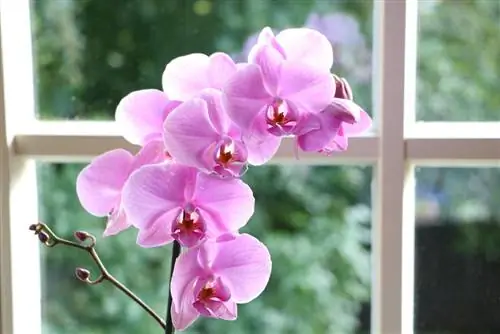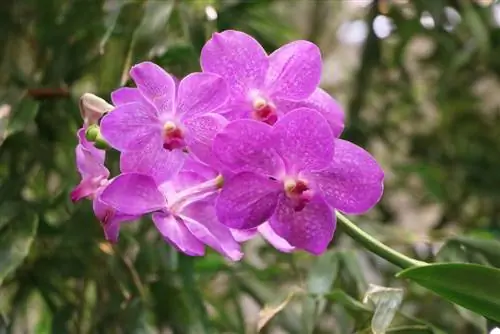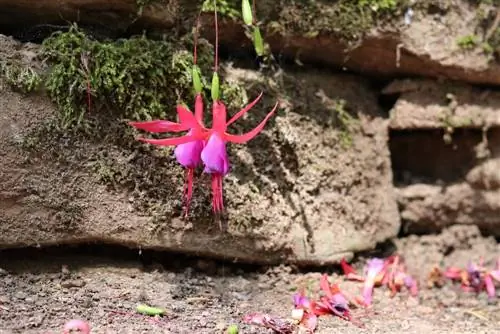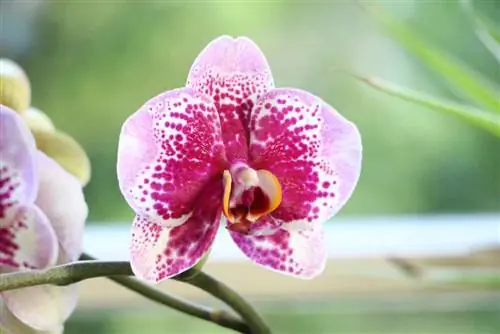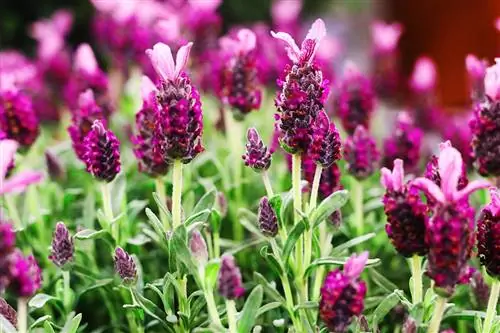- Author admin [email protected].
- Public 2023-12-17 03:39.
- Last modified 2025-01-24 12:45.
The butterfly orchid has the botanical name Phalaenopsis and seduces with its exotic flowers in the shape of a butterfly. With good care and the right location conditions, the plant will bloom for many months. Since orchids are used to a warm climate, they can only be kept indoors with lots of sun. Butterfly orchids can be cultivated both as delicate individual plants and in a magnificent ensemble.
Location & Temperature
Due to its origins in tropical countries, the butterfly orchid can only be cultivated as a houseplant. When it comes to temperatures and humidity, the Phalaenopsis has certain requirements that must be met in order for the orchid to thrive. As a rule, the plant copes well with normal living room temperatures. In addition, the room must be ventilated regularly, otherwise the roots may rot. However, if the temperature differences are very large, i.e. more than 10° C, then the plant should be moved to a protected location for a short time during ventilation.
- Needs a bright location, but without blazing midday sun
- A sunny window sill with an east or west orientation is ideal
- Grows well in a temperate greenhouse or winter garden
- Needs fresh air, but cannot tolerate drafts
- Temperature values must not fall below 16° C all year round
- In summer, values up to 30° C are bearable, at night a little under 20°
- In winter at least 20° C during the day, not cooler than 16° C at night
- Perfect humidity is 50%
- Spray regularly with steam
Tip:
If the butterfly orchid gets shade from decorative nets or other plants during midday, then it can also thrive on the south window.
Planting substrate
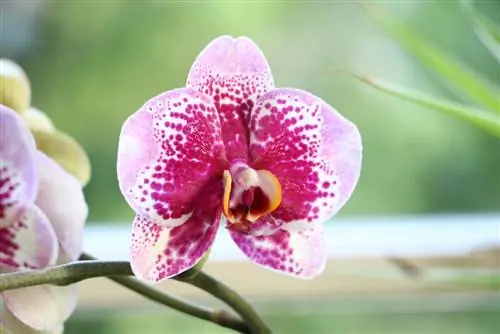
Orchids are epiphytic plants whose roots do not connect firmly to the soil, but simply sit there. The substrate should therefore only fit very loosely around the roots, giving the plant good support and the opportunity to draw sufficient moisture from it. Orchids absorb the liquid with their roots like a sponge. If you start growing orchids, you should first get the finished planting substrate from a specialist retailer. Knowledgeable orchid growers can mix the right substrate themselves. The right substrate prevents root rot and does not enrich them too much with the s alts from the fertilizer.
- Needs particularly coarse and stable substrate
- Humus and other nutrients are good
- Relies on adequate ventilation of the roots
- The following mixture is ideal: peat and swamp moss, rotted leaves, chopped fern roots, crushed cork and pieces of bark from conifers
- Optimal pH value is between 5 to 5.5, i.e. slightly acidic
- Sensitive to too much lime in the soil
Watering & Fertilizing
The Phalaenopsis prefers a humid climate. However, in most living rooms the radiators are mostly mounted under the windowsill, which is the ideal location for the plant. For this reason, it is exposed to heating air that is much too dry in the cold season. In general, it can be said that the warmer and brighter the plants are, the more water they need. For butterfly orchids, the plant substrate must not be left dry for too long. Although the plants can tolerate short-term drought, this phase is not helpful for the development of he althy flowers and many leaves.
- Watere weekly in summer, every two weeks in winter
- Alternatively, an immersion bath is also possible
- Only water when the substrate is already dry
- Avoid waterlogging as this leads to root rot
- Soft and lime-free water is ideal
- Watering water should never be too cold, but rather lukewarm
- Spray aerial roots lightly with a little water in the morning
- Do the same for dry heating air
- Only fertilize during the growth phase
- Fertilize every four weeks
- Orchid fertilizer, weakly concentrated, is optimal
Flowers, leaves & growth

The butterfly orchid is a very popular type of orchid that catches the eye with its elegant and exotic shape. The plant owes its meaningful name to the unusual flower shapes that look like tropical butterflies. Phalaenopsis are extremely flowery and robust, making them ideal for inexperienced orchid keepers. The butterfly orchids do not go dormant; the plants continue to grow all year round. However, growth slows in the winter months due to the lack of light and colder temperatures.
- Wide variety of flower colors, even multi-colored possible
- Purple, blue, yellow, orange, red, pink and white flowers
- Flowering time depends on the variety
- Usually blooms from January to February, then again October to December
- Green leaf color with oval leaf shape
- Midday sun can burn the leaves in spring
- Do not cut off leaves with some burnt spots
- Upright growth, forms rosettes
Tip:
After flowering, it is an advantage to place the orchids in a slightly cooler location until the new flower spikes have formed.
Repotting
Since orchids are epiphytes, they rely on a good hold in the planter. That's why it should never be too big, but the plant grows over the years and then needs more space. Repotting is possible all year round, at the latest when a new shoot no longer has enough space. In addition, the substrate must be replaced if it is leached. The plant substrate should also be rinsed every 2-3 months to avoid salinization of the roots due to fertilization.
- Use new plant substrate when repotting
- Free the roots completely from the old substrate in advance
- Remove damaged and dead plant parts and roots
- New planter should be approx. 3 cm larger than the previous one
- Afterwards, moisten the roots with a spray bottle
Cutting
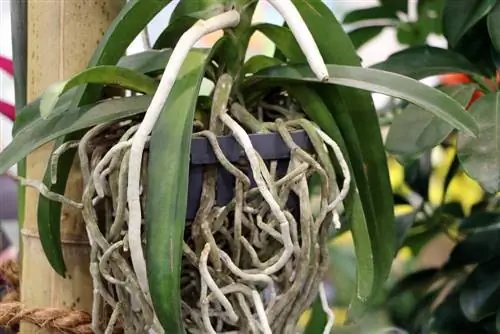
When pruning, less is more when it comes to the he alth of the butterfly orchid. The older leaves on the lower side become dry over time and die on their own. If flowers that have already withered are cut off from the shoot, this cut promotes the emergence of further flower panicles. Dead stems should also be removed so that the Phalaenopsis can grow new stems. The sensitive roots should not be trimmed unless there are rotten spots. In this case, the old plant substrate must be disposed of to prevent renewed infection of he althy root areas.
- Carefully pick off dead and dried leaves
- Cut off wilted flowers if necessary
- Carefully cut out rotting root pieces
- To be on the safe side, replace the substrate immediately
- Cut off flowering stems
- Make the cut over the second to third knot from the bottom
- Use only sharp cutting tools
- Disinfect everything thoroughly beforehand
Wintering
Wintering in living rooms and heated greenhouses is not a problem, but the temperature must not fall below 16°C. The butterfly orchids simply remain in their usual location during the winter. If there is extensive ventilation in the immediate area, the plants should be moved to a warm and protected place during this period. Some experts recommend overwintering the orchids much colder, at temperatures between 5°-10° C. This approach is intended to positively promote flowering in the next growing season. However, the casting units must be extremely limited because otherwise rotting can occur at these low temperatures.
- Don’t let the plant dry out
- Fertilizing is not necessary during this time
- Be careful when ventilating
- Counteract extremely dry heating air
- Keep humidity evenly high
- Place the bowl of water under the pot
Propagate

The butterfly orchids can also be propagated on your own. Phalaenopsis form new buds from the shoot eyes on the pseudobulbs or directly on the flower stalk. Regular propagation keeps the plants he althy and keeps them blooming. In this way, the orchid collection is constantly growing and there is always a nice gift idea at hand.
- Propagation possible by sowing or kindling
- Cut off kindle and insert into new substrate
- Sowing is difficult and only for specialists
- New varieties can be grown by sowing
Diseases & Pests
Diseases in orchids cultivated in this country are mainly caused by permanently wet roots. In this way, bacteria and fungi receive a perfect breeding ground. If pruning results in large wounds and unclean cuts, then bacteria can penetrate the plant unhindered. If the flower buds fall off more frequently, this is not always an indication of illness. These symptoms often appear after a change or when the location conditions are incorrect. Too little light, not enough water and low humidity weaken the plants' immune system in the long term. In the event of a pest infestation, only use products intended for orchids.
- Check regularly for infestations and diseases
- Susceptible to scale insects, spider mites and mealybugs
- Wipe pests with soapy water and rinse with clean water
- If symptoms of illness occur, check site conditions
- Does not tolerate continuous smoke in the air
- Ethylene caused by fruit ripening is perceived as a nuisance
- Avoid drafts at all costs

